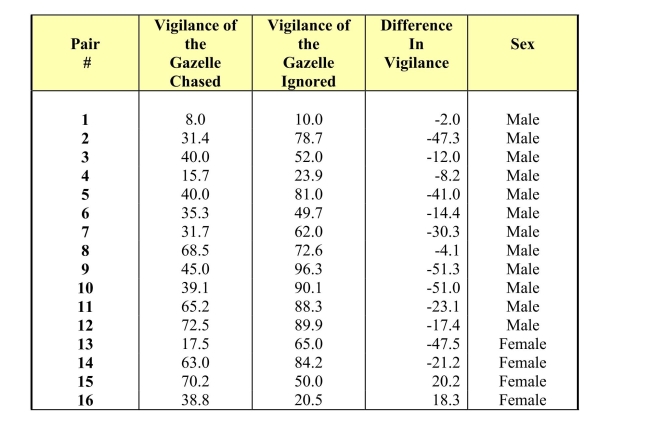Essay
When stalking gazelles, cheetah frequently have a choice between two gazelles closeto each other while grazing. A biologist thought the choice of prey might be affectedby the "vigilance" behavior of the gazelles. She defined vigilance as the percentageof the time that a gazelle had its head in the air searching for potential predators. Shefilmed cheetah stalks and analyzed 16 incidents where two same-sex gazelles werewithin 5 meters of each other; thus, either could have been chosen as the cheetah's prey. The table below presents the vigilance levels for each of the gazelles and thedifference (gazelle chased - gazelle ignored) for each pair. 
a) Using the scales below, construct comparative dotplots to show that it isreasonable to use the t-procedure to construct confidence intervals for thedifference in population means for males and females. 
b) Calculate and interpret the 95% confidence interval in the context of the problem.c) The investigator noticed that many more male pairs than female pairs wereactually stalked by cheetah. Two theories have been proposed for this difference.The first theory is that the gazelle females are generally more vigilant than males.The second theory is that females generally graze near the centers of the herds,protecting the young, and are less accessible to predators.i) Is it possible to use investigator's data be used to support or refute the theorythat females are more vigilant than males?
Is so, how?
If not, why not?
ii) Is it possible to use investigator's data be used to support or refute the theorythat females generally graze near the centers of the herds?
Is so, how?
If not,why not?
Correct Answer:

Verified
a) 
b) 
Since 0 is in the confidence i...View Answer
Unlock this answer now
Get Access to more Verified Answers free of charge
Correct Answer:
Verified
b)
Since 0 is in the confidence i...
View Answer
Unlock this answer now
Get Access to more Verified Answers free of charge
Q1: Two samples are said to be independent
Q5: A number of butterfly species mate for
Q6: For both large and small samples the
Q7: After an outbreak of a drug-resistant strain
Q8: In an introductory marketing class students were
Q9: The estimated standard deviation of <img src="https://d2lvgg3v3hfg70.cloudfront.net/TB5309/.jpg"
Q11: Male and female Downy Woodpeckers (Picoides pubescens)
Q12: In a study of captive nectar-feeding bats
Q13: "Tail-chasing" by dogs is an anxiety disorder
Q15: For paired samples <img src="https://d2lvgg3v3hfg70.cloudfront.net/TB5309/.jpg" alt="For paired